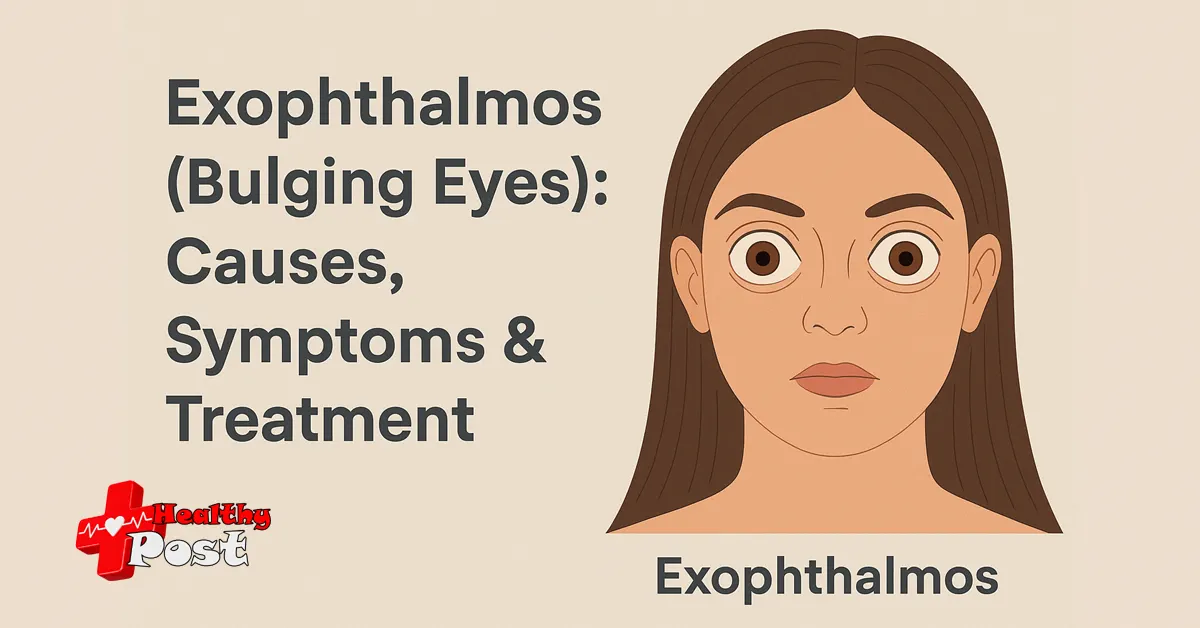
What is Exophthalmos (bulging eyes) cause, symptoms and treatment
Exophthalmos (bulging eyes) is a symptom that manifests itself as a forward displacement of one or both eyeballs, with possible deviation to the side. At the same time, the eyeball itself remains normal in size (unlike ‘bull’s eye’, in which there is an increase in the eyeball, which is observed in congenital glaucoma).
Often, exophthalmos is treated not by an ophthalmologist, but by an endocrinologist, traumatologist or oncologist (depending on the cause that caused the appearance of this symptom).
Causes of occurrence
Exophthalmos is caused by many diseases. Thus, in some types of thyroid diseases, especially in diffuse toxic goiter (Graves’ disease), the tissues of the orbit swell and push the eyeball forward. Exophthalmos can also occur as a result of bleeding from a vessel behind the eye or inflammation of the tissues of the orbit. In addition, tumors, malignant or benign, can form in the orbit behind the eyeball, which push it forward. There is also an atypical growth of tissues of the orbit (pseudotumor, that is, a false neoplasm), in which exophthalmos develops within 2-3 weeks.
Thrombosis of the cavernous sinus is also accompanied by swelling of the soft tissues due to difficulty in the outflow of blood through the veins extending from the eye. A pathological anastomosis (communication) between arteries and veins (arteriovenous shunt) behind the eye can be accompanied by the formation of pulsating exophthalmos, in which the eye bulges forward and pulsates in time with the heartbeat.
Other causes of exophthalmos may include:
- Inflammatory diseases of the lacrimal glands, inflammatory processes of the fatty tissue of the orbit, inflammation of the blood vessels or vasculitis of the orbital vessels.
- Tumors of the orbit.
- Trauma with hemorrhage behind the eyeball.
- Varicose veins of the orbit.
- Endocrine ophthalmopathy.
Exophthalmos (Bulging Eyes) Symptoms: What to Look Out For
Exophthalmos, also known as proptosis or bulging eyes, is a condition where one or both eyes protrude abnormally. This outward displacement is often linked to underlying medical conditions, with thyroid eye disease (TED) being the most common cause. Recognizing early symptoms of exophthalmos can help prevent complications and improve treatment outcomes.
Common Symptoms of Exophthalmos
The primary symptom of exophthalmos is noticeable bulging of the eyes. However, individuals may also experience several related signs, including:
- Eye pain or pressure, especially behind the eyeballs
- Dryness or excessive tearing due to incomplete eyelid closure
- Redness and inflammation of the eyes or eyelids
- Double vision or difficulty focusing
- Sensitivity to light (photophobia)
- Restricted eye movement in severe cases
- Ulceration or damage to the cornea if left untreated
When to See a Doctor
If you notice any persistent change in the appearance or function of your eyes, especially bulging, consult a healthcare professional promptly. Exophthalmos may signal a deeper issue like Graves’ disease, tumors, or infections that require medical attention.
Effective Treatment Options for Exophthalmos (Bulging Eyes)
Exophthalmos, commonly referred to as bulging eyes, often occurs due to underlying conditions like Graves’ disease or orbital tumors. Timely treatment is essential to reduce inflammation, restore normal eye positioning, and prevent long-term damage.
Medical Treatments for Exophthalmos
The first line of treatment typically involves managing the root cause, such as thyroid dysfunction. Antithyroid medications or radioactive iodine therapy are often prescribed to regulate thyroid hormone levels. In cases linked to autoimmune thyroid disorders, corticosteroids like prednisone can reduce inflammation around the eyes.
For patients with severe swelling or vision issues, doctors may recommend immunosuppressive drugs to control the immune response. These medications help relieve pressure within the eye socket, decreasing bulging and discomfort.
Surgical Treatments
When conservative treatments fail or symptoms persist, surgery may be necessary. Orbital decompression surgery is commonly performed to remove bone or fat from behind the eye, creating space and relieving pressure. This restores the eye to a more natural position.
In cases of muscle dysfunction or double vision, eye muscle surgery can help align eye movement. Eyelid surgery may also be considered to improve closure and protect the cornea from dryness or damage.
Supportive Therapies
Supportive measures like lubricating eye drops, cold compresses, and wearing sunglasses can help reduce dryness, irritation, and light sensitivity. Smoking cessation is highly recommended, as smoking exacerbates symptoms and slows recovery.
Regular monitoring by an ophthalmologist or endocrinologist ensures that treatment is effective and complications are minimized. Tailored treatment plans based on severity and underlying cause are key to successful recovery.

